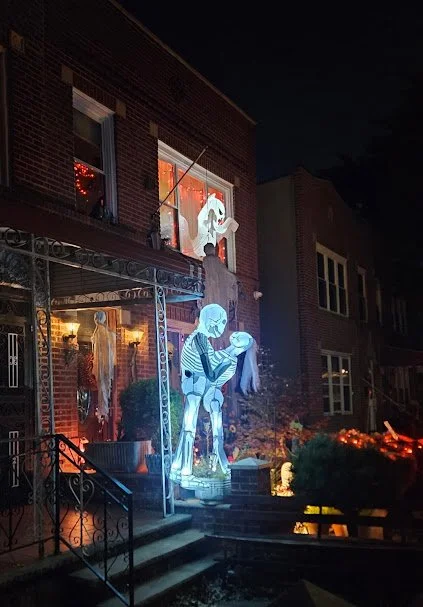Spectacle and Shadows: Halloween in the City That Never Sleeps
Purefinder New York’s walking tours run year-round, uncovering the forgotten layers of the city’s past. Yet each October, as the nights grow longer, the history beneath New York’s streets feels particularly vivid. From early immigrant customs to theatrical celebrations and modern myths, Halloween reveals how the city has always blurred the line between belief and invention.
William Mumler’s spirit photography, 1860s
A City Built on Spirits and Spectacle
The roots of Halloween reach back to the ancient Celtic festival of Samhain, when the end of harvest marked a time of transition. In New York, those ancient rituals took on new meanings through immigration and reinvention. By the mid-19th century, the city had become a center for Spiritualism, séances, and psychic exhibitions. William Mumler, a photographer on Broadway, became briefly famous for his “spirit photographs,” claiming to capture the images of the dead standing beside the living. Across the city, newspapers covered séances, public lectures, and displays of automatic writing as serious cultural pursuits.
Belsnickelers in 1910
Belsnickelers and Disguise
Long before trick-or-treating became a Halloween custom, a German-American practice called belsnickeling appeared in parts of Pennsylvania and New York State during the 19th century. Participants, often disguised in ragged clothing and masks, went from house to house performing songs or riddles while their neighbors tried to guess their identities. If they succeeded, the visitors might receive no reward; if not, they were given small treats or cakes. The tradition, once part of winter celebrations, shared the same spirit of playful anonymity and mischief that would later shape American Halloween.
The youngest child in this photograph, on the far left, was posthumously posed with the aid of a stand, a common practice in Victorian mourning photography.
Strange Shadows of the Gilded Age
In the Victorian and Gilded Age city, mourning was not hidden but expressed through art, fashion, and ritual. Locks of hair were woven into jewelry, photographers offered “last portraits,” and parlors displayed memorial art made from family relics.
Victorian Memento Mori Mourning Hair Wreath
The Merchant’s House Museum in Manhattan preserves this atmosphere, its furnishings and stories revealing how New Yorkers once balanced faith, grief, and propriety.
This fascination with the boundary between life and death even touched the world of entertainment. Harry Houdini, the great illusionist and skeptic of fraudulent mediums, died on Halloween, 1926, after spending his final years publicly challenging those who claimed to speak with the dead.
Treats, Tricks, and Tainted Myths
The practice of trick-or-treating evolved from centuries-old customs of guising and souling, when children and the poor went door to door offering prayers or performances in exchange for food. Immigrant communities brought those traditions to the United States, where they gradually merged into the modern Halloween ritual by the early 20th century. By mid-century, national candy companies turned the night into a commercial event centered on individually wrapped sweets.
The New York Times, Oct 28, 1970
Public fears of poisoned or tampered candy surfaced in the 1960s and 70s, fueled by sensational media reports. Yet sociologist Joel Best, who has studied these cases for decades, found no verified instances of children being harmed by tainted Halloween treats. The myth likely reflects a broader unease about community trust and industrial food production. Ironically, those same fears helped solidify store-bought candy as the “safe” choice, transforming Halloween into one of America’s most successful consumer rituals.
The Headless Horseman Pursuing Ichabod Crane (1858) by John Quidor
Headless Legends and Haunted Valleys
Just beyond the city, along the Hudson, Washington Irving’s The Legend of Sleepy Hollow remains the most enduring of all New York tales. Written in 1820, the story of Ichabod Crane and the Headless Horseman blends colonial folklore and superstition with Irving’s own satirical wit.
Lyndhurst Mansion, Tarrytown, NY
Today, Tarrytown and Sleepy Hollow celebrate that legacy with historical tours through Philipsburg Manor, Lyndhurst Mansion, Sunnyside, and the Sleepy Hollow Cemetery. The nearby Great Jack O’Lantern Blaze fills the night with thousands of carved pumpkins, echoing the fiery harvest rituals that inspired early Halloween traditions.
Village Halloween Parade, Manhattan, NY
A Parade of Masks and Meaning
In modern New York, the spectacle of Halloween reaches its height in the Village Halloween Parade, which began in 1973 as a neighborhood puppet procession and grew into one of the city’s most distinctive public events. Each year, thousands of participants take to Sixth Avenue in costume, transforming the street into a moving work of performance art. The recurring “Thriller” dance, now a parade tradition, reflects the night’s blend of choreography and controlled chaos. What started as a local expression of creativity has become a defining symbol of New York’s ability to turn history and ritual into public theater.
Purefinder New York’s tours explore the layers of the city’s history through its archives and forgotten corners. They are not about ghosts, but about the traces that remain: the rituals, industries, and ideas that shaped New York’s relationship with life, death, and reinvention. In the season of Halloween, those stories are ripe for investigation. Join us as we explore how myth becomes memory and how the city continues to transform darkness into spectacle.
History is closer than we think.













